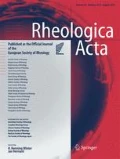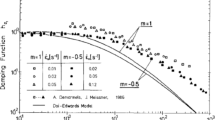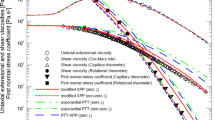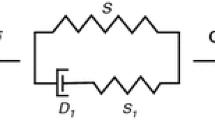Abstract
This work presents a framework for collectively modeling shear viscosities of grouped polymeric materials. The viscosity model has been derived from the multi-modal White-Metzner constitutive equation. Simplification to the multi-modal viscosity has resulted in a viscosity model that controls gradual transition between two conventional viscosity models. It facilitates mathematical representation of multiple sets of viscosity data at the same time. A conventional shear viscosity function, which is common to the group, is multiplied by a material-specific function with one or two constants to form the collective viscosity model. The proposed framework has been applied to several polymeric systems such as polymers with varying molecular weight, polymer solutions with different concentrations, polymers with different filler loadings, and polymer blends with various composition ratios. It has been shown that the K-index in the proposed viscosity model and the variable in the material system such as concentration or compounding ratio can be correlated with each other to predict the viscosities of untested cases.












Similar content being viewed by others
References
Bird RB, Armstrong RC, Hassager O (1987) Dynamics of polymeric liquids Vol. 1. Wiley, New York
Casanellas L, Alves MA, Poole RJ, Lerouge S, Lindner A (2016) The stabilizing effect of shear thinning on the onset of purely elastic instabilities in serpentine microflows. Soft Matter 12:6167–6175
Carreau PJ (1972) Rheological equations from molecular network theories. Trans Soc Rheol 16:99–127
Churchill SW, Churchill RU (1975) A general model for the effective viscosity of pseudoplastic and dilatant fluids. Rheol Acta 14:404–409
Cox WP, Merz EH (1958) Correlation of dynamic and steady flow viscosities. J Polym Sci 28:619–622
Cross MM (1965) Rheology of non-Newtonian fluids—a new flow equation for pseudoplastic systems. J Colloid Sci 20:417–437
Cross MM (1979) Relation between viscoelasticity and shear-thinning behaviour in liquids. Rheol Acta 18:609–614
Dames B, Morrison BR, Willenbacher N (2001) An empirical model predicting the viscosity of highly concentrated, bimodal dispersions with colloidal interactions. Rheol Acta 40:434–440
Doi M, Edwards SF (1979) Dynamics of concentrated polymer systems. Part 4. Rheological properties. J Chem Soc Faraday Trans 2 75:38–54
Ewoldt RH, Hosoi AE, McKinley GH (2008) New measures for characterizing nonlinear viscoelasticity in large amplitude oscillatory shear. J Rheol 52:1427–1458
Franck A (2018) Understanding rheology of thermoplastic polymers. TA Instruments Application Notes Library AAN01
Haley CJ, Lodge TP (2004) A framework for predicting the viscosity of miscible polymer blends. J Rheol 48:463–486
Han CD (2007) Rheology and processing of polymeric materials Vol. 1. Oxford University Press
Housiadas KD, Tanner RI (2014) A model for the shear viscosity of non-colloidal suspensions with Newtonian matrix fluids. Rheol Acta 53:831–841
Kim SK (2018) Flow-rate based method for velocity of fully developed laminar flow in tubes. J Rheol 62:1397–1408
Kim SK (2019) Flow rate based framework for solving viscoplastic flow with slip. J Non-Newtonian Fluid Mech 269:37–46
Kwon KC, Park YK, Floyd T, Nader V, Erica J, Paul J (2007) Rheological characterization of shear-thinning fluids with a novel viscosity equation of a tank-tube viscometer. Appl Rheol 17:51413
Macosko CW (1994) Rheology: principles, measurements and applications. Wiley-VCH
Martys NS, George WL, Chun BW, Lootens D (2010) A smoothed particle hydrodynamics-based fluid model with a spatially dependent viscosity: application to flow of a suspension with a non-Newtonian fluid matrix. Rheol Acta 49:1059–1069
Mendoza CI (2017) A simple semiempirical model for the effective viscosity of multicomponent suspensions. Rheol Acta 56:487–499
Morris ER, Cutler AN, DA RSB-M, Rees J, Price (1981) Concentration and shear rate dependence of viscosity in random coil polysaccharide solutions. Carbohydr Polym 1:5–21
Oldroyd JG (1950) On the formulation of rheological equations of state. Proc Royal Soc A: Mathematical, Physical and Engineering Sciences 200:523–541
Quemada D (1978) Rheology of concentrated disperse systems II. A model for non-Newtonian shear viscosity in steady flows. Rheol Acta 17:632–642
Rošic RJ, Pelipenko P, Kocbek S, Baumgartner M, Bešter-Rogacˇ KJ (2012) The role of rheology of polymer solutions in predicting nanofiber formation by electrospinning. Eur Polym J 48:1374–1384
Shenoy A (1999) Rheology of filled polymer systems. Springer, Dordrecht
Sisko AW (1958) The flow of lubricating greases. Ind Eng Chem 50(12):1789–1792
Tadmor Z, Gogos CG (2006) Principles of polymer processing 2nd Ed., Wiley
Tanaka F, Edwards SF (1992) Viscoelastic properties of physically crosslinked networks: Part 1. Non-linear stationary viscoelasticity. J Non-Newtonian Fluid Mech 43:247–271
Thiébaud F (2011) Determination of an innovative consistent law for the rheological behavior of polymer/carbon nanotubes composites. Soft Nanoscience Letters 1:1–5
White JL, Metzner AB (1963) Development of constitutive equations for polymeric melts and solutions. J Appl Polym Sci 7(5):1867–1889
Yang HH, Han CD, Kim JK (1994) Rheology of miscible blends of poly(methyl methacrylate) with poly(styrene-co-acrylonitrile) and with poly(vinylidene fluoride). Polymer 35:1503–1511
Yasuda K, Armstrong RC, Cohen RE (1981) Shear flow properties of concentrated solutions of linear and star branched polystyrenes. Rheol Acta 20:163–178
Funding
This work was supported by the National Research Foundation of Korea (NRF) grant funded by the Korean government (MSIT) (NRF-2014R1A2A1A11054451 and NRF-2018R1A5A1024127).
Author information
Authors and Affiliations
Corresponding author
Additional information
Publisher’s note
Springer Nature remains neutral with regard to jurisdictional claims in published maps and institutional affiliations.
Rights and permissions
About this article
Cite this article
Kim, S.K. Collective viscosity model for shear thinning polymeric materials. Rheol Acta 59, 63–72 (2020). https://doi.org/10.1007/s00397-019-01180-w
Received:
Accepted:
Published:
Issue Date:
DOI: https://doi.org/10.1007/s00397-019-01180-w




